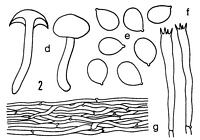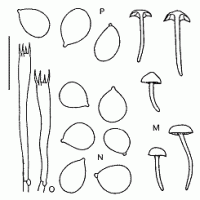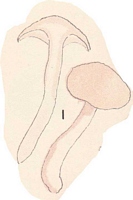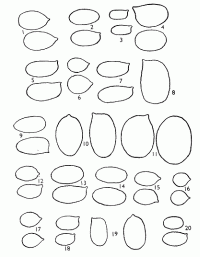|
 Camarophyllus muritaiensis Camarophyllus muritaiensis
SynonymsHygrophorus muritaiensis
Camarophyllus muritaiensis
BiostatusPresent in region - Indigenous. Endemic
Images (click to enlarge)
Caption: Camarophyllus muritaensis (Stev.) (type): d. carpophores. - e. spores. - £ basidia. - g. cuticle | 
Caption: Fig. 20 Camarophyllus muritaiensis (Stev.) Horak. (M-O: ZT 1019): M. basidiomes. N, spores. O. basidia. (K 1352, type): P. spores. |  | 
Caption: Spores X 2000 1. Hygrophorus salmonipes 2; H. elsae; 3, H .julietae; 4, H. variabilis; 5, H. lilaceo-lamelllatus; 6, H. muritaiensis; 7, H. keithgeorgei; 8, H. pseudococcineus; 9, H. rubro-carnosus; 10, H. miniceps; 11, H. procerus; 12, H. multic | |
Article: Horak, E. (1990). Monograph of the New Zealand Hygrophoraceae (Agaricales). New Zealand Journal of Botany 28(3): 255-306 (http://www.rsnz.org/publish/abstracts.php).
Description: Pileus -20 mm, hemispherical or convex, centre flat to subdepressed in aged
basidiomes; pale salmon to pink; dry, smooth to minutely fibrillose, non-striate
margin. -Lamellae 10-16 (1 -3) decurrent to arcuate, pink to pale argillaceous,
edges concolorous, entire. - stipe 20-40 x 2-4 mm, cylindrical or gradually
attenuated towards base; white or concolorous with, pileus; dry, smooth to silky,
base occasionally strigose, solid, single. –Context pale argillaceous to pink.
- Odour and taste not distinctive. - Chemical reactions unknown.
Spores 5-7.5 x 4.5-5.5 um, subglobose to ovoid. - Basidia 30 -55 x 5-6 um,
4-spored. – Cystidia absent. -Pileipellis a cutis of interwoven, cylindrical,
hyphae (4-8 um diam.), membrane not gelatinised, minutely encrusted with pigment;
clamp connections present (Pl. 1, Fig. 5).
Habitat: ECOLOGY: Rare; saprobic on soil among litter in Nothofagus-Leptospermum
forests. June.
Distribution: DISTRIBUTION: NZ (NA, W).
Article: Horak, E. (1971). A contribution towards the revision of the Agaricales (Fungi) from New Zealand. New Zealand Journal of Botany 9(3): 403-462 (http://www.rsnz.org/publish/abstracts.php).
Notes: Hygrophorus muritaiensis Stevenson (28 D) = Camarophyllus muritaiensis
(Stevenson) comb. nov. (Basionym: H. muritaiensis Stevenson, Kew Bull. 16:
378, 1962)
Article: Stevenson, G. (1963) [1962]. The Agaricales of New Zealand: IV. Kew Bulletin 16(3): 373–384.
Description: Pileus 1-2 cm. diam., salmon pink, hemispherical, dry, smooth, finely fibrillose;
flesh pink-tinged, continuous with stipe. Gills decurrent, tinged pink, rather
thick, moderately distant. Stipe 3-4 cm. X 3-4 mm., White, solid, smooth, silky.
Spores 6-7 X 5-6 µm., pyriform, hyaline, walls slightly thickened Basidia 60
X 6 µm., four-spored.
Habitat: habitat: mossy banks under .Nothofagus forest, Muritai,
2.6.1958, Conrad Cone.
Article: Horak, E. (1973). Fungi Agaricini Novazelandiae I-V. Beihefte zur Nova Hedwigia 43: 200 p.
Description: 'Pileus 10-20 mm diam., salmon pink, hemispherical, dry, smooth, finally fibrillose; flesh pink-tinged, continuous with stipe. Gills decurrent, tinged pink, rather thick, moderately distant. Stipe 30-40 x 3-4 mm, white, solid, smooth, silky'.
Spores 6.5-8 x 4.5-5.5 µm, ovoid to subglobose, smooth, inamyloid. Basidia 45-55 x 6 µm, 4-spored. Cystidia absent. Gill trama of interwoven hyphae. Cuticle a cutis consisting of repent, densely woven, not gelatinized hyphae (4-8 µm diam.). Clamp connections numerous.
Habitat: On mossy banks under Nothofagus. New Zealand.
Notes: In dried condition the carpophores of C. muritaensis (Stev.) resemble very much C. virgineus (Fr.) but fresh fruiting bodies are distinguished at once by the salmon pink coloured pileus and lamellae.
|